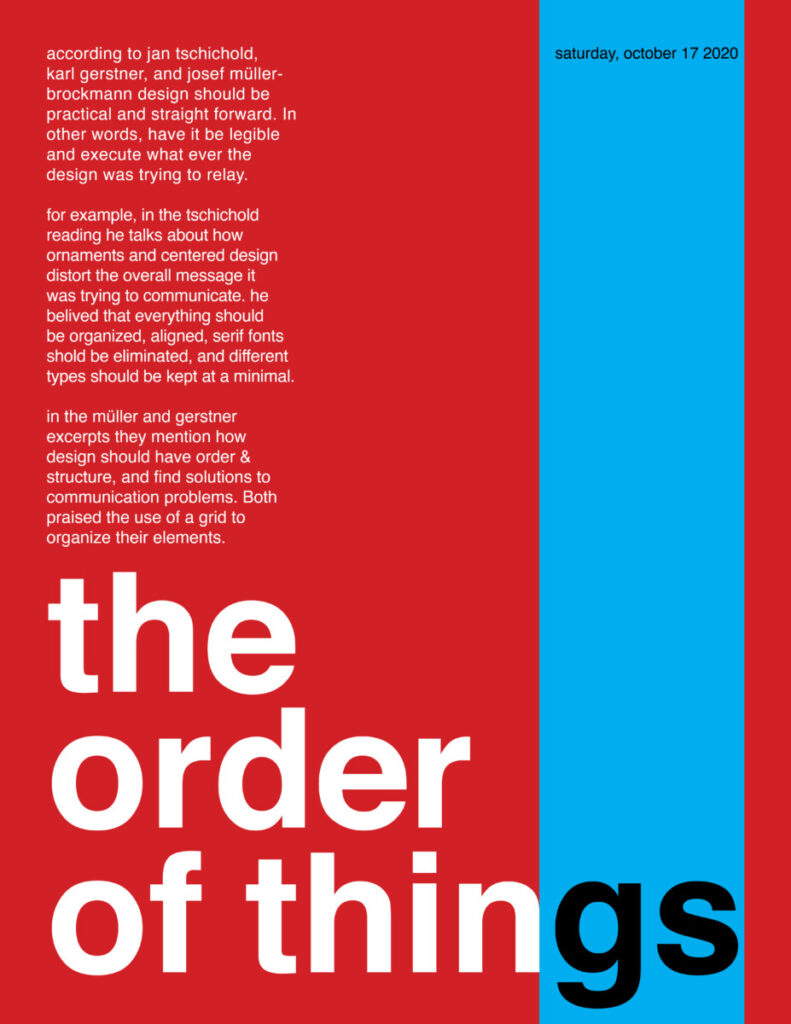

COMD3504 - Section OL01 - Fall 2020

When reading the three short texts from architects/designers associated with the Bauhaus movement, I realized that there is a great emphasis on photography, typography, and language on how it can be used as a way to communicate with people through art and design and to make it easier to communicate with another, with the exception of Walter Gropius’s essay. At least from my understanding.
For example in Herbert Bayer’s On Typography, there is a section where he talks about the creation of the Universal type font. In that font he eliminated serifs and capital letters, making it more legible and straightforward. He even eliminated capital letters in his text, with the exception of sub-titles. His goal was to have something ubiquitous that would bridge the gap between languages. On the other hand it seemed like her considered verbal language as a hindrance to universal communication. I say that because he starts his paragraph with “for a long time to come we will accept the existence of the different languages now in use. this will continue to pose barriers to communication, even after improved (possibly phonetic) writing methods have been adopted within all the languages.”
In László Moholy-Nagy’s Typofoto he talks about the possibility of new technology emerging, like the typography. In the essay he mentions how simply having having photo and text strips aways any individual interpretation away. But with typophoto, it creates something ambiguous, subjective in an “optically valid form.” As he would put it, “Typophoto is the visually most exact rendering of communication.”
When it came to Walter Gropius’s The Theory and Organization of the Bauhaus, it was hard to understand. I may be wrong here but I did not see too much of an emphasis on communication well at least not between person and design. The essay was more about how art is not a profession and no amount schooling will be enough to make someone an artist. He also goes on to say that ‘the academy’ have or had a grip on art, making it stagnate. Which is understandable because in my opinion, every art and design movement was a rebelling against academic/the fine arts. And how academic training brought great art-proletariat that were destined to social misery.
When I was reading The Futurist Manifesto, I began to feel a bit unease. The manifesto romanticizes war as if it is glorious and beautiful sight to behold, as if it’s “the only cure of world.” The reading mentions “We want to sing the love of danger, the habit of energy and rashness.” and invoking apex predators like lions. The text also states that women are beneath consideration. It is very machismo and hypermasculine.
It is also reminiscent of fascism. The manifesto shines a warm light on patriotism and militarism, which are signs fascism. It also states how museums, libraries, and academic buildings should be razed to the ground and left behind. These were ideaologies that were common in Nazi Germany and fascist Italy.
The constructivist manifesto was a bit harder to understand but the way I interpret it as followed. Design and art should be separate. That in some ways being imaginative is childish. While design is meticulous and it should be functional instead of worrying about aesthetics. These points are touched upon many times, for example in one line it mentions that “We are not dreamers from art who build in the imagination: Aeroradiostations, Elevators, and, Flaming cities. We—are the beginning our work is today: A mug,
A floor brush, Boots, A catalog, And when one person in his laboratory set up A square.”
While El Lissitzky take on constructivism was about how for a long time the fine arts where stagnating, overrated, and losing meaning. But the introduction of new technology has caused art to “evolve.” He makes this apparent when bringing up photomontage and typomontage. How they make printing and design more exciting instead of being dull.
© 2024 Communication Design Theory
Theme by Anders Noren — Up ↑
Recent Comments